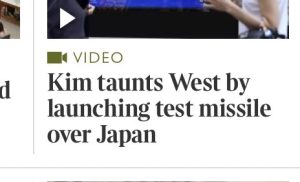Maritime forces from Canada, Japan and the United States concluded exercises in the South China Sea Oct. 1, demonstrating a shared commitment to a free and open Indo-Pacific, said Commander, Task Force 71/Destroyer Squadron 15 Public Affairs. The Japan Maritime Self-Defense Force (JMSDF) led the exercise in support of their Indo-Pacific deployment,Strengthening our #NavyPartnerships! 💪 ⚓ Sailors aboard #USSBenfold work with @jmsdf_pao_eng and #ROKNavy personnel during an anti-submarine warfare exercise in the Waters East of the Korean Peninsula. 📸 : by MC2 Arthur Rosen pic.twitter.com/2d5uebR5Zs
— U.S. Navy (@USNavy) October 7, 2022

So, SoKo and the US responded. If this doesn’t all smack of escalation in the South China sea, what does?#Japan‘s MOD map of #NorthKorea‘s Hwasong-12 intermediate-range ballistic missile launch on Oct. 4th The longest range missile tested so far by N. Korea. Japanese air raid warning systems kicked in & people took shelter. Range: 4,600 km Apogee: 1,000 km Flight time: 22 minutes pic.twitter.com/1czbgvL3Pt
— Indo-Pacific News – Geo-Politics & Military News (@IndoPac_Info) October 5, 2022
South Korea and the United States conducted a precision bombing exercise in response to North Korea’s launch of a ballistic missile over Japan on Tuesday, South Korea’s Joint Chiefs of Staff (JCS) announced in a statement.
— Kylie Atwood (@kylieatwood) October 4, 2022
